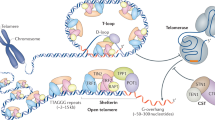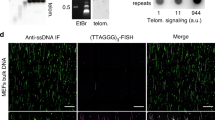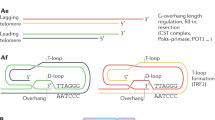Abstract
TELOMERES define the ends of chromosomes; they consist of short tandemly repeated DNA sequences loosely conserved in eukaryotes (G1–8T/A)1–4)1. Telomerase is a ribonucleoprotein which, in vitro, recognizes a single-stranded G-rich telomere primer and adds multiple telomeric repeats to its 3′ end by using a template in the RNA moiety2–6. In conjunction with other components, telomerase may balance the loss of telomeric repeats due to DNA replication7. Another role of telomerase may be the de novo formation of telomeres. In eukaryotes like Tetrahymena, this process is an integral part of the formation of macronuclear chromosomes8. In other eukaryotes this process stabilizes broken chromosomes. A case of human α-thalassaemia is caused by a truncation of chromosome 16 that has been healed by the addition of telomeric repeats (TTAGGG)n (ref. 9). Using an in vitro assay4, I show here that human telomerase correctly recognizes the chromosome 16 breakpoint sequence and adds (TTAGGG)n repeats. The DNA sequence requirements are minimal and seem to define two modes of DNA recognition by telomerase.
This is a preview of subscription content, access via your institution
Access options
Subscribe to this journal
Receive 51 print issues and online access
$199.00 per year
only $3.90 per issue
Buy this article
- Purchase on Springer Link
- Instant access to full article PDF
Prices may be subject to local taxes which are calculated during checkout
Similar content being viewed by others
References
Blackburn, E. H. Cell 37, 7–8 (1984).
Greider, C. W. & Blackburn, E. H. Cell 43, 405–413 (1985).
Shippen-Lentz, D. & Blackburn, E. H. Molec. cell. Biol. 9, 2761–2764 (1989).
Morin, G. B. Cell 59, 521–529 (1989).
Greider, C. W. & Blackburn, E. H. Nature 337, 331–337 (1989).
Yu, G.-L., Bradley, J. D., Attardi, L. D. & Blackburn, E. H. Nature 344, 126–132 (1990).
Blackburn, E. H. Nature 350, 569–573 (1991).
Blackburn, E. H. & Karrer, K. M. A. Rev. Genet. 20, 501–521 (1986).
Wilkie, A. O. M., Lamb, J., Harris, P. C., Finney, R. D. & Higgs, D. R. Nature 346, 868–871 (1990).
Murray, A. W., Claus, T. E. & Szostak, J. W. Molec. cell. Biol. 8, 4642–4650 (1988).
Shippen-Lentz, D. & Blackburn, E. H. Science 247, 546–552 (1990).
Williamson, J. R., Raghuraman, M. K. & Cech, T. R. Cell 59, 871–880 (1989).
Sundquist, W. I. & Klug, A. Nature 342, 825–829 (1989).
Greider, C. W. & Blackburn, E. H. Cell 51, 887–898 (1987).
Henderson, E. R., Hardin, C. C., Wolk, S. K., Tinoco, I. & Blackburn, E. H. Cell 51, 899–908 (1987).
Zahler, A. M., Williamson, J. R., Cech, T. R. & Prescott, D. M. Nature 350, 718–720 (1991).
Matsumoto, T. et al. Molec. cell. Biol. 7, 4424–4430 (1987).
Gilley, D., Preer, J. R., Aufderheide, K. J. & Polisky, B. Molec. cell. Biol. 8, 4765–4772 (1988).
Pologe, L. G. & Ravetch, J. V. Cell 55, 869–874 (1988).
Kamper, J., Meinhardt, F., Gunge, N. & Esser, K. Molec. cell. Biol. 9, 3931–3937 (1989).
Adam, R. D., Nash, T. E. & Wellems, T. E. Molec. cell. Biol. 11, 3326–3330 (1991).
Yao, M.-C., Yao, C.-H. & Monks, B. Cell 63, 763–772 (1990).
Baroin, A., Prat, A. & Caron, F. Nucleic Acids Res. 15, 1717–1728 (1987).
Forney, J. D. & Blackburn, E. H. Molec. cell. Biol. 8, 251–258 (1988).
Klobutcher, L. A., Jahn, C. L. & Prescott, D. M. Cell 36, 1045–1055 (1984).
Klobutcher, L. A., Vailonis-Walsh, A. M., Cahill, K. & Ribas-Aparicio, R. M. Molec. cell. Biol. 6, 3606–3613 (1986).
Herrick, G., Hunter, D., Williams, K. & Kotter, K. Genes Dev. 1, 1047–1058 (1987).
Klobutcher, L. A., Huff, M. E. & Gonye, G. E. Nucleic Acids Res. 16, 251–264 (1988).
Yao, M.-C., Zheng, K. & Yao, C.-H. Cell 48, 779–788 (1987).
Ledbetter, D. H. et al. Proc. natn. Acad. Sci. U.S.A. 86, 5136–5140 (1989).
Gusella, J. F. et al. Nature 318, 75–78 (1985).
Author information
Authors and Affiliations
Rights and permissions
About this article
Cite this article
Morin, G. Recognition of a chromosome truncation site associated with α-thalassaemia by human telomerase. Nature 353, 454–456 (1991). https://doi.org/10.1038/353454a0
Received:
Accepted:
Issue Date:
DOI: https://doi.org/10.1038/353454a0
Comments
By submitting a comment you agree to abide by our Terms and Community Guidelines. If you find something abusive or that does not comply with our terms or guidelines please flag it as inappropriate.



